Plethysmography
Complete Plethysmography Research Solutions
Real-time Pulse Transit Time and blood volume measurements
Advanced Plethysmography hardware/software combinations support wide variety of experiments
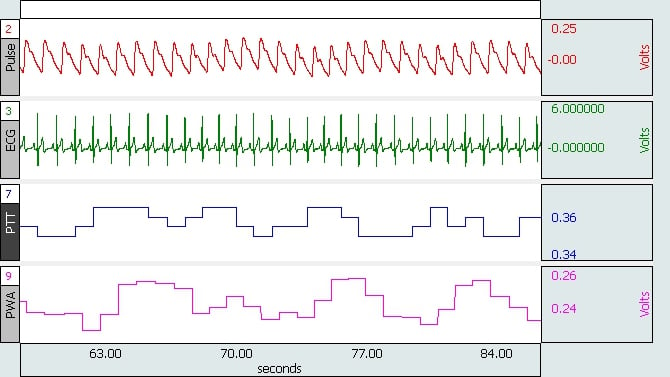
PPG Recording & Automated Analysis
Record and analyze plethysmography data from a variety of body locations. Record pulse rate from the fingers, ears or toes for heart rate calculation or pulse transit time studies. Look at variations in appendage size or blood volume changes to regions of the body to examine venous capacitance, outflow, and compliance measures. For indirect approximation of blood pressure changes, record the pulse signal while occluding and releasing the brachial artery. Automated routines are available for cycle/peak detection and rate calculation to measure the area under the pulse waveform for an indication of blood volume.
Try plethysmography research tools in the free AcqKnowledge Demo
See More...Hardware Packages | Plethysmography
Hardware Bundles are complete solutions for the specified application. Choose your preferred platform and bundle, then click "Request Pricing" to request an estimate, add/remove items, or complete purchase. If you have questions about specific items, click through to the product web page for details and specifications, or contact your Local Sales contact.
Wired
-
MP36R System for Pulse measurement
Wired | Plethysmography
MP36R with AcqKnowledge plus Photoplethysmogram transducer for Pulse measurement
-
MP160 System with PPG amp and finger transducer
Wired | Plethysmography
MP160 System with PPG amplifier and finger transducer
MP36R System for Pulse measurement
- 1 x MP36R Systems
- 1 x Photoplethysmogram for Pulse Waveform - MP3X/45
MP160 System with PPG amp and finger transducer
- 1 x MP160 Data Acquisition Systems
- 1 x Photoplethysmogram Transducers
- 1 x Photo Plethysmogram Amplifier
Wireless
-
MP160 System plus wireless PPG with Pulse transducer
Wireless | Plethysmography
MP160 with AcqKnowledge plus BioNomadix wireless PPG & Pulse transducer
-
BioNomadix Logger with Pulse setup
Wireless | Plethysmography
BioNomadix Logger plus one pulse transmitter and wireless Pulse setup
MP160 System plus wireless PPG with Pulse transducer
- 1 x MP160 Data Acquisition Systems
- 1 x Wireless Pulse Transducers - BioNomadix
- 1 x BioNomadix Wireless PPG and EDA Amplifier
BioNomadix Logger with Pulse setup
- 1 x BioNomadix Wireless Wearable Physiology Logger
- 1 x Wireless Pulse Transducers - BioNomadix
MRI
-
MP160 System with PPG amp & finger transducer for MRI
MRI | Plethysmography
MP160 System with PPG amplifier and finger transducer for MRI
MP160 System with PPG amp & finger transducer for MRI
- 1 x MP160 Data Acquisition Systems
- 1 x Photo Plethysmogram Amplifier for MRI
- 1 x Photoplethysmograph Transducer for MRI
Animal
-
MP36R System for Pulse measurement
Animal | Plethysmography
MP36R with AcqKnowledge plus Photoplethysmogram transducer for Pulse measurement
MP36R System for Pulse measurement
- 1 x MP36R Systems
- 1 x Photoplethysmogram for Pulse Waveform - MP3X/45
Details
Derive BPM
A very reliable BPM subject data can be collected with the PPG100C-MRI photoplethysmogram amplifier and associated PPG transducer. It is generally much easier to perform a PPG measurement on a subject, as all that’s required to perform a PPG is an accessible finger or toe. Only one attachment point is required to perform a BPM measurement, using PPG, versus three attachment points (via electrodes), using ECG. Rate (BPM) can be derived from the PPG signal, using a standard or MRI Smart amplifier signal. The data is this graph illustrates an overlap comparison of the rate (BPM) data derived from a PPG100C-MRI amplifier as compared to BPM data derived from a ECG100C-MRI amplifier. Both the PPG data and ECG data were collected, on the same subject, at the same time. Note that the derived BPM results are very similar, excepting one point which is a result of switching artifact when the 10 Hz LP filter on the PPG100C-MRI amplifier was switched to 3 Hz LP.
Advanced Features Spotlight
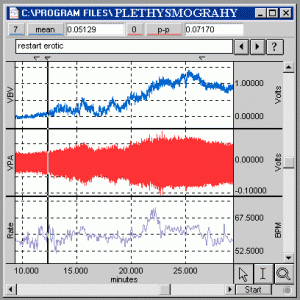
Measure variations in blood flow indirectly via changes in opacity with the plethysmogram transducer for tethered, wireless and MRI applications. Typically, a blood volume pulse More...
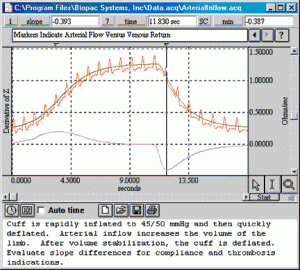
To analyze regional blood flow, occlude the venous return with the blood pressure cuff (TSD120) and measure the swelling of the distal portion of the More...
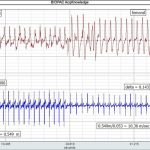
Carotid to Femoral Pulse Wave Velocity (cfPWV) measurement
Classic (gold standard) Carotid to Femoral Pulse Wave Velocity (cfPWV) measurement using BIOPAC’s MP160 Data Acquisition System with AcqKnowledge Research Software, Transducer Amplifier DA100C, Electrocardiogram More...
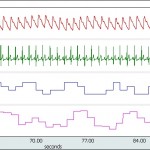
Pulse Transit Time (PTT), Pulse Wave Velocity (PWV) and Pulse Wave Amplitude (PWA)
Pulse Transit Time (PTT) is the time it takes the Pulse Pressure (PP) waveform to propagate through a length of the arterial tree. The pulse More...
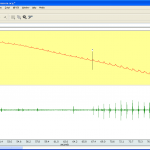
Indirect Blood Pressure Recordings
Record indirect blood pressure with a blood pressure cuff (TSD120) and a contact microphone (TSD108) placed over the brachial artery. Increase cuff pressure to occlude the More...
Videos
AcqKnowledge Find Cycle Peak Detector - Part 1
AcqKnowledge Find Cycle Peak Detector - Part 2
AcqKnowledge Find Cycle Peak Detector - Part 3
AcqKnowledge Find Cycle Peak Detector - Part 4
AcqKnowledge Find Cycle Peak Detector - Part 5
AcqKnowledge Find Cycle Peak Detector - Part 6
BIOPAC NIBP-MRI: How to Apply Sensor to Brachial Artery
Support
Application Notes
- 130 - Noninvasive Blood Pressure Measurement - TSD120
- 154 - High Level Transducer Connections - HLT100C
- 159 - Hand Switch and Foot Switch - TSD116 Series
- 103 - Remote Monitoring System - TEL100
- 110 - Amplifier Baseline Offset Adjustment
- 126 - Wireless Remote Monitoring - TEL100C-RF
- 136 - Battery Pack Instructions - BAT100
- 185 - iMac and G3 Compatibility Issues
- 195 - MP System Data Sampling Reference
- 207 - UDP Install: MP150 + No Network Access
- 208 - UDP Install: MP150 + Domain Network Access
- 209 - UDP Install: MP150 + Network Access or Multiple Computers
- 223 - Physiological Measurement in Magnetic Resonance Imaging Systems
- 121 - Waveform Data Reduction
- 142 - Rate Detector Algorithm in AcqKnowledge
- 143 - Importing AcqKnowledge Data Into Excel
- 155 - AcqKnowledge File Formats for the Macintosh
- 156 - AcqKnowledge File Formats for PC With Windows
- 191 - Digital I/O Channels
- 204 - AcqKnowledge Peak Detector Operation
- 218 - Hardware API
- 219 - Known Issues - AcqKnowledge
- 117 - Pulse Transit Time and Velocity Calculation
- 001 - AcqKnowledge Release and OS Compatibility
- 294 - Trans-radial Electrical Bioimpedance Velocimetry (TREV and TRUEV)
Knowledge Base
- AC mode
- AcqKnowledge accuracy
- AcqKnowledge backwards compatibility
- Amplifier baseline offset adjustment
- Amplifier conversion - 2 mm to touchproof
- Amplifier filter settings
- Audio recording synchronization
- Band-pass and band-stop filters
- Bioimpedance Methods
- Buffer overflow
- Calculating file sizes
- Combining Video with AcqKnowledge
- Common mistakes/general troubleshooting
- Connecting the TSD116C Switch Box
- Copy and paste append markers along with data
- DC mode
- Deep breath and PPG signal flattening
- Duplicating waveforms
- ECG R-wave detector
- Editing noisy data
- Electrode Properties - gel and adhesive
- Excel files exported from BIOPAC software open in Excel 'Protected View'
- Exporting Data to SPSS
- External Devices and Channel Contention
- Extracting data segments from a file
- High pass filters
- IIR vs. FIR filters
- Interfacing third-party transducers
- LabView interface
- Low pass filters
- MP150 UDP protocol fixed IP address
- MRI - Triggering
- MRI, Radiotranslucent, and Radio-opaque Compatibility
- NIBP100A and pulse plethysmography
- Notch filter
- Optimal ground placement
- Outputting a signal through the STM100C
- Physiological measurements - life science signals using BIOPAC
- PPG setup and calibration
- Railing signal (flatline)
- Recording good data
- Text files - import and export
- Upgrading from PCMCIA to USB
- USB Drivers and Controller Communication
- Using other software with BIOPAC hardware
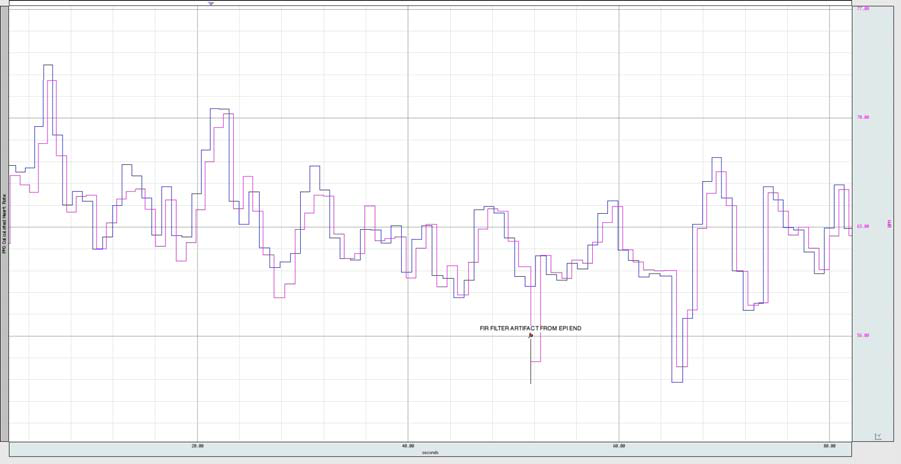
Stay Connected